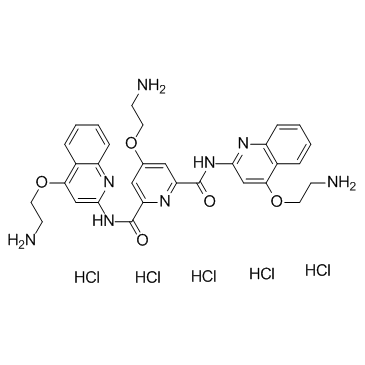Pyridostatin hydrochloride
Modify Date: 2025-08-25 18:35:02

Pyridostatin hydrochloride structure
|
Common Name | Pyridostatin hydrochloride | ||
|---|---|---|---|---|
| CAS Number | 1781882-65-2 | Molecular Weight | 778.94 | |
| Density | N/A | Boiling Point | N/A | |
| Molecular Formula | C31H37Cl5N8O5 | Melting Point | N/A | |
| MSDS | N/A | Flash Point | N/A | |
Use of Pyridostatin hydrochloridePyridostatin hydrochloride is a G-quadruplexe stabilizer, with a Kd of 490 nM. |
| Name | Pyridostatin hydrochloride |
|---|
| Description | Pyridostatin hydrochloride is a G-quadruplexe stabilizer, with a Kd of 490 nM. |
|---|---|
| Related Catalog | |
| Target |
Kd: 490 nM (G-quadruplexe)[1] |
| In Vitro | Pyridostatin hydrochloride is a G-quadruplexe stabilizer, with a Kd of 490 nM[1]. Pyridostatin (PDS) shows neurotoxic activity against primary cortical neurons at 0.01-5 μM, causes DNA double-strand breaks (DSBs) at 1 μM, downregulates BRCA1 in neurons at 1, 2 or 5 μM[2]. Pyridostatin interacts with G-quadruplex motifs in SRC and alters mRNA levels of damaged genes[3]. |
| Cell Assay | Cells are plated at equal confluence and either untreated or treated with 2 μM Pyridostatin continually for 72 h. Cells from individual plates are trypsinized and counted in a Coultercounter. Graphs represent total cell numbers at each time interval and error bars represent S.E.M. Data represent three independent experiments[3]. |
| References |
| Molecular Formula | C31H37Cl5N8O5 |
|---|---|
| Molecular Weight | 778.94 |
| InChIKey | SRIZPFGTXSQRFM-UHFFFAOYSA-N |
| SMILES | Cl.Cl.Cl.Cl.Cl.NCCOc1cc(C(=O)Nc2cc(OCCN)c3ccccc3n2)nc(C(=O)Nc2cc(OCCN)c3ccccc3n2)c1 |
| Storage condition | 2-8℃ |